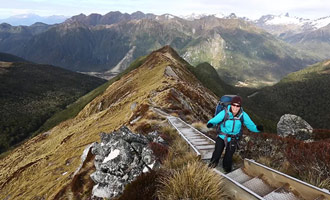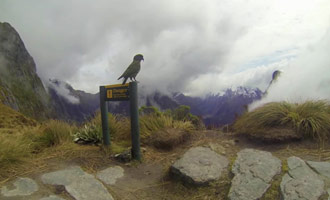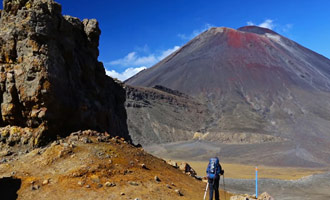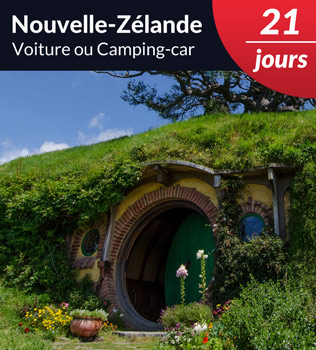
The Guide to Hiking in New Zealand.
Please contact us and we will help you to organize your trip! It's free and without commitment.
- Read the post
- Details
- Advices
The Practical Guide of the Activity.
- 1Hiking in the Lord of the Rings' Country.
- 2How to Dress for Hiking?
- 3Choose Your Hiking Shoes.
- 4Which Hike to Choose in New Zealand?
- 5Should You Train Before Departure?
- 6The Great Walks of New Zealand.
- 7Te Araroa Trail: A 3,000 Km Hike!
- 8Safety Instructions for Hikers.
- 9Practical Advice for Beginners (Without Jargon)
Hiking in the Lord of the Rings' Country.
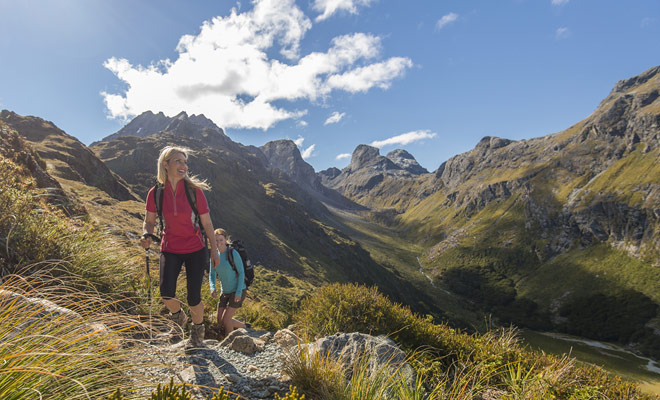
New Zealand is a dream country for hikers.
National parks and animal reserves cover 2/3 of New Zealand. If it is in excellent condition, the road network is deliberately restricted in protected areas or in National Parks. Hiking is often the only way to reach the magnificent landscapes that have made the country reputation and you may have seen already in The Lord of the Rings.
When planning your stay, you will hear of the Tongariro Alpine Crossing sooner or later. This spectacular walk is considered the most beautiful one-day hike to New Zealand. But there are nine other great walks that await you all over the country.
In addition to these great walks, there are hundreds of easy excursions suitable for beginners and families. But if you like to meet the challenges, you can live a great adventure and camp in the heart of the wild nature, a stone's throw from a fjord or a paradisiac beach.
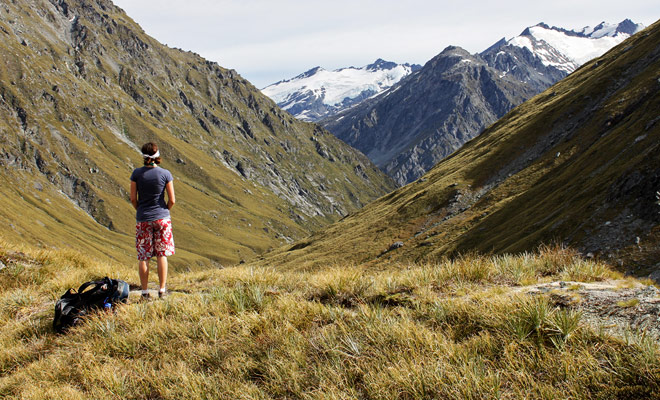
Impressive landscapes without visible traces of civilization.
But among all these choices, you need to know which hikes to choose, and how to equip yourself for long walks that might be exhausting without a minimum of organization. A significant part of this file is also dedicated to safety, because if the tracks are well maintained and signs posted, there is nevertheless a kind of hiker's code that you must respect to the letter to stay clear from danger.
Hiking is New Zealand's most beautiful outdoor activity!
If come with the hope to find the landscapes of the Hobbit universe, you will not be disappointed! A minimum of motivation is essential to fully enjoy it, and you might need to prepare yourself, doing more physical exercise than usual during the months before departure. Welcome to the Ultimate Hiker's Guide to New Zealand!
How to Dress for Hiking?

The long hikes impose a minimum of equipment.
Because the seasons are reversed on the other side of the globe, the perfect outfit can be difficult to find in European stores before departure. You could plan to buy a part of your equipment directly in New Zealand, but you would take the risk to pay a higher price. You should consider equipping yourself at least six months in advance.
It is customary to say that a traveler can experience four seasons during the very same day in New Zealand. There is some truth in this saying, and I know that filling a suitcase is quite hard when you have no clear idea about the weather that you might have on location! There is, however, an unbeatable solution to this problem...
The Trick of the Three Superimposed Layers
Rather than packing all your wardrobe, I recommend that you choose lightweight clothing you could add or remove easily accordingly to the weather. A good hiking backpack should allow you to store or use a layer of clothing at any time.
If it is necessary to avoid being cold during a mountain hike, it is also not advisable to be too much covered (you might suffer of dehydration). If walking makes you sweat, you should be able to remove a layer of clothing even in the middle of winter.
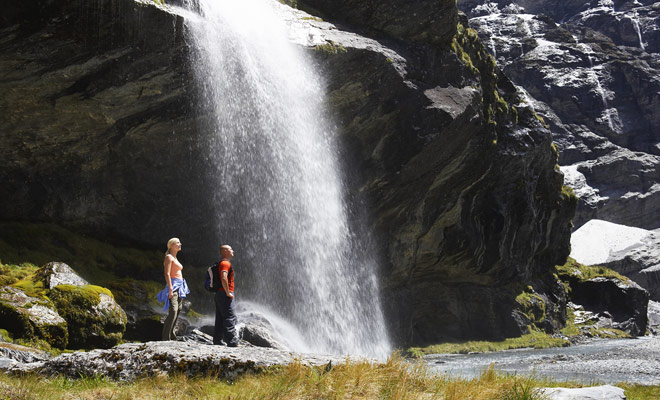
Use lightweight, easy-to-remove clothing.
A suitable equipment for hiking consists of a t-shirt in a synthetic fibers, a fleece jacket and a raincoat with hood. Depending on the season, the warm anorak (preferably in Gore-Tex or equivalent) will replace the anorak. It is the famous “three layers superimposed”, system which has proved to be adapted to most situations and which is also recommended by all hiking guides. The first layer evacuates perspiration, the second retains heat and the third protects from wind and rain.
You might consider wearing a long sleeve t-shirt in winter, but you must avoid cotton t-shirts because they don't evacuate sweat properly.

The hiking pants should not interfere with walking.
Hiking Pants
The hiking pants must be waterproof, cut close to the body, but ample enough not to hinder walking (a good one could be difficult to find and might be expensive). Depending on the season, basic short-pants will suffice, but mountain hiking in a country where the weather is subject to sudden changes in temperature requires towearing pants all year round.
Leave your jeans in the closet, as they take hours to dry in case of rain and would prevent you to warm yourself.
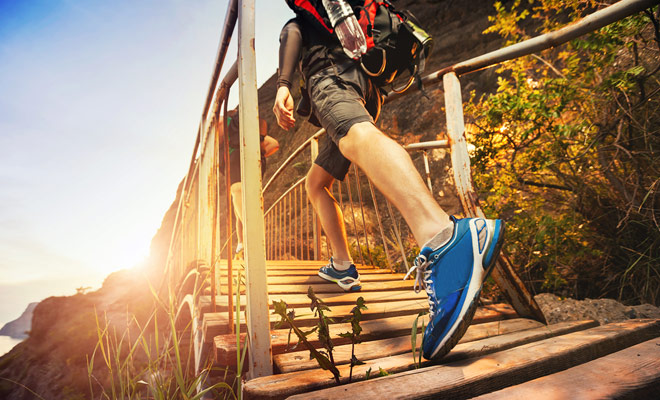
Good hiking shoes are essential.
Hiking Footwears
The classic sneakers will be enough for the short walks, but the most difficult excursions require good hiking shoes.
If they seem heavy at first, their reinforced stability contributes to reduce fatigue and you will feel the difference at the end of the day.
Do not wait until the last minute to buy your hiking shoes!
Depending on the trek, you are considering following in New Zealand, a true expert would suggest mountaineering or hiking shoes adapted to the duration of the walk and the type of terrain to cross. But in reality, the occasional walker essentially needs a pair of rigid shoes to limit the trauma caused by fatigue at the end of the day.
If your budget allows it, I recommend buying your shoes in dedicated hiking stores rather than in a commercial center.

The choice of the shoes should not be made at the last minute.
In New Zealand, where rainfall is abundant, the shoes must always be waterproof, which does not mean that you need to buy plastic boots!
The soles should be in soft gum for hiking in the forest, but rigid enough to be suitable to mountain trails.
The discomfort caused by a bad pair of hiking shoes is not always perceptible in the store!
It is better to test your new shoes during short walks in your home country. But remember to clean the shoes thoroughly in order to pass the biosafety checks of the airport without a problem.
The women have more fragile feet than men's, and their skin is more easily irritated by the repeated rubbing on the shins. Finding suitable shoes is not so easy, but you should take your time to choose.
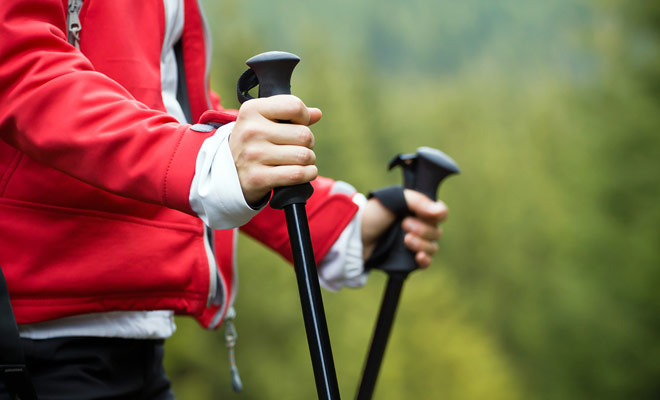
Walking sticks are not reserved for seniors.
Walking Sticks
Walking sticks are not reserved for the elderly, as they divide the hiker's fatigue by two. And because they facilitate the phases of ascent or descent, they reduce the aches in the knees and allow to practice longer outdoor activities.
But beware, because if walking sticks are not expensive, they hardly hold in baggage!
Even folded, an adult model measures about 80 cm, and only the large suitcases can store them.
It may be better to buy his sticks in New Zealand from $15 to $35 instead of investing a lot of money in a bulky suitcase.

A good backpack should be adapted to your body shape.
The Accessories
The list of accessories to bring is easy to prepare, but requires some common sense.
To the maps are added gourds, supplies, dynamo torches, first aid kits, sandflies repellents, sunscreens ... not to mention sunglasses and telephones with the emergency numbers of the country.
The headgear is too often neglected! A hat is often indispensable in the mountains as it helps to protect you effectively against sunburn.
Choose Your Hiking Shoes.
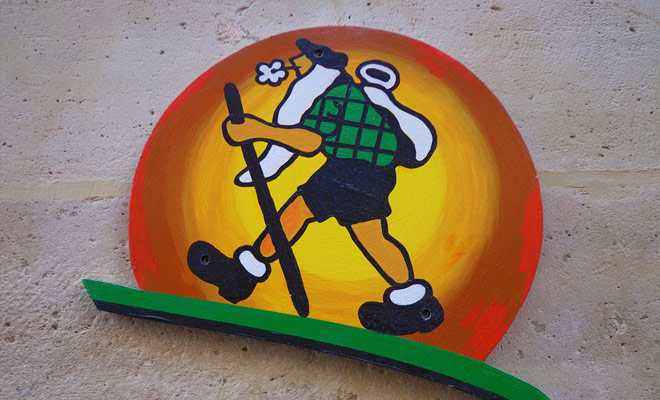
Kiwipal recommends specialized mountain shops.
Because the choice of trekking shoes is essential, I have decided to complete this “special hiking” guide with an entire section to help you to find shoes at your feet.
Buying hiking shoes on the Internet is obviously to be avoided! Of course, my own opinion on the subject cannot replace the advice of a real expert, but I recommend you to avoid the major sports shops where salesmen only ask if you can touch the extremity of the shoe with our toes...
Even a feeling of comfort can be deceptive! It often takes several hours of hikes on a real mountain terrain to ensure the quality of a shoe model.

Never buy your hiking shoes on the internet!
To avoid playing Russian roulette with your toes, I recommend you to consult an expert seller to seek professional advice. Most good sellers are themselves passionately by hiking and they won't try to sell you a pair of shoes at all costs.
Here are the key points to know before passing the door of a store:
Where Do You Plan to Hike?

For a hiking shoe, the aesthetic is the last criterion.
The aesthetics of a model is the last aspect to take into account! Take a moment to really consider the treks you plan to do, and when you'll visit a store you'll easily see if the salesperson is trying to understand your profile and if his advice is serious: if not, you may consider going to another store.
What Shoe Size?
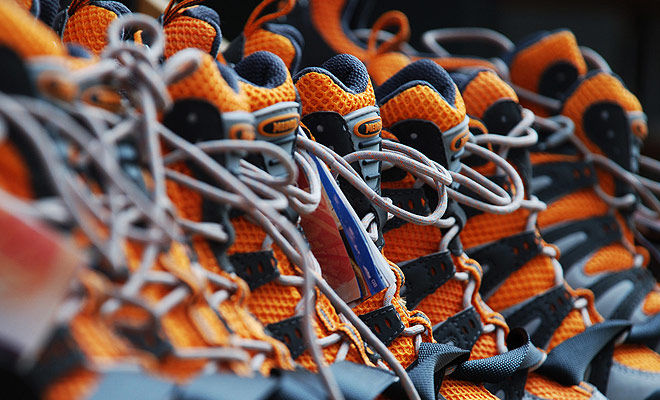
Consider taking a larger size!
For rigid shoes suitable for hiking on difficult terrain, you should consider a size larger more than usual.
A half-size will be enough for soft shoes. If it is normal to feel your foot tighter than usual, you must not feel hampered, however!
Try your future shoes with sports socks, and walk to the store instead of taking the bus.
If you walk during half an hour before coming, your foot swells enough to recreate the conditions of a hike and you are more likely to buy the appropriate shoes.
What Rigidity?
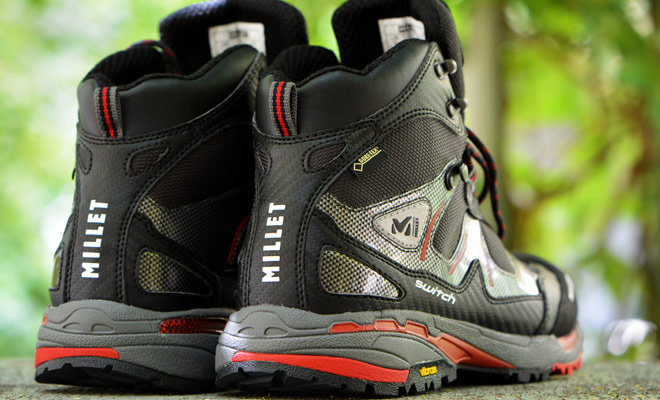
The shoes should be stiff enough, but not over-tighten!
A soft sole is suitable for short walks on flat ground, while a rigid sole adapts to the irregular trails of mountains. The sole soft folds easily with your hands, unlike the hard sole (this is how you can differentiate them easily). As often, one must seek compromise and try versatile models!
What Waterproofing?
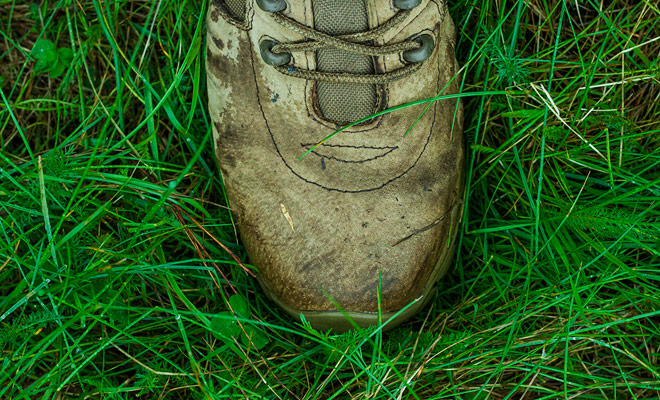
The shoes should be waterproof, but allow the foot to breathe.
Contrary to popular belief, a shoe should not be perfectly waterproof and the foot must be able to breathe. Without aeration, the risks of blisters are multiplied by ten! Read labels carefully and don't be afraid to question sellers. For New Zealand, you can opt for hiking shoes since the grass is often wet in the morning!
How to Try the New Shoes?
Put on the shoes without lacing them, then stand up and slide your foot into the shoe until your toes touch the tip. In this position, a small gap of one to two centimeters should exist at the heel. Without this gap you risk the sprain, and if it is too big on the contrary, then you multiply the risks of blisters!

Can you store shoes and walking sticks fitting in a suitcase?
Check if your heel does not rise too high when walking, after lacing the shoe without tightening it to the maximum.
Your toes should not be compressed, and you should be able to stir them. Finally, if your feet are oriented diagonally to the outside, try another model!
There are other factors such as lightness and waterproofing to consider. Our advice does not absolve you from seeking the advice of a specialist in store.
Consider buying special hiking socks, more expensive but very effective in preventing blisters.
Which Hike to Choose in New Zealand?
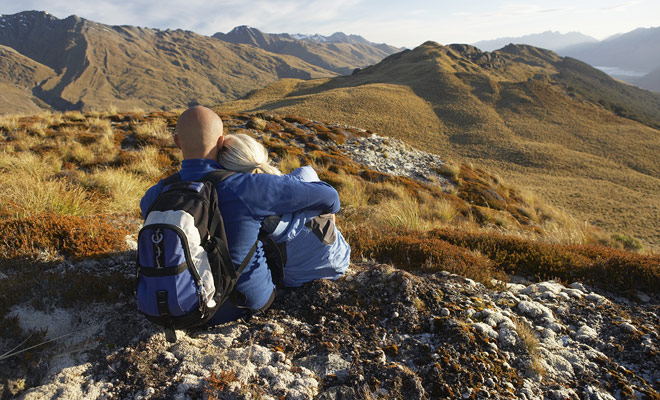
Find yourself alone in the wild nature.
You will be spoiled for choice in New Zealand, a country considered to be the best in the world for hiking. The variety of terrain and the epic landscapes multiply your forces and make you want to go beyond your limits.
The “Great walks of New Zealand” are the most spectacular. But there are many exceptional tracks that you can follow for a few hours without being an athlete.
Most of the great hikes in New Zealand are ranked among the best in the world.
If you are athletic and accustomed to mountain hikes, you can consider the itineraries of several days with camping nights. But do not overestimate your abilities! Taking part in a great hike is not a decision to take lightly.

The great hikes impose a good physical condition.
It's not enough to train two weeks before the start to turn into a marathon runner! A senior who practices three times a week can easily beat a young adult who prefers the sofa to physical exercise.
If you are healthy, a great hike on a day (the Tongariro Crossing for example), and short walks are suitable for a few weeks' stay.
You can also content yourself for easy walks: the Abel Tasman National Park with low elevation is accessible to all. Hiking should be a pleasure and not an obligation during your holidays!
Should You Train Before Departure?

Not to be exhausted fast, you need a bit of training.
By summing the distances traveled during city walks with small and large hikes, a stay of a few weeks in New Zealand easily includes from 70 to 150 km of the walk!
The World Health Organization (WHO) recommends walking about 10,000 steps per day (about 8 km) to stay fit. This represents an hour and a half of walking in the day.
If your daily exercise is limited to a few hundred meters a day, you will need more training to be able to walk the 19.6 km of the Tongariro Alpine Crossing in just one day.

Pedometers are perfect for training.
To test your actual physical capabilities, a first step is to get a step counter. There is an infinity of accessories (like an iWatch) and free applications for smartphones that will do the trick. This can help to become aware of a sedentary life and allow to set reasonable goals to improve.

The hikes are well laid out, but you have to be fit.
If you plan to follow a great walk, you should test your resistance on a walking day prior to your departure to New Zealand.
Walk for a minimum of 6 hours with a few breaks. If the experiment is a failure, this leaves you little hope of facing a difficult mountain trek like the Tongariro Alpine Crossing.
The physical capacities of everyone are not transposable, and weather conditions can change the situation anytime.
You should only listen to the advice of your doctor, and do not try to push your limits if you are not a confirmed sportsman.
Hiking is not a competition, you are not doing it to impress other people.

Follow your own rhythm, hiking is not a speed race!
You could train yourself correctly for a few months to get fit. Try to walk at least 10,000 steps each day during the two months before your stay (you won't always have the time, but try at least to get close to this goal). Under these conditions, you should hold the distance without any problem in New Zealand.
The Great Walks of New Zealand.

Enjoy the landscapes of the Lord of the Rings.
Among the nine most beautiful walks in New Zealand (the famous Great Walks), some are classified as UNESCO World Heritage, others have served as natural settings for films like The Lord of the Rings trilogies and the Hobbit.
There are three great walks on the North Island, five on the South Island and a final one on Stewart Island. The most accessible of all these walks is undoubtedly the Tongariro Alpine Crossing which takes place in the landscapes of The Lord of the Rings (the Mordor's scenes).
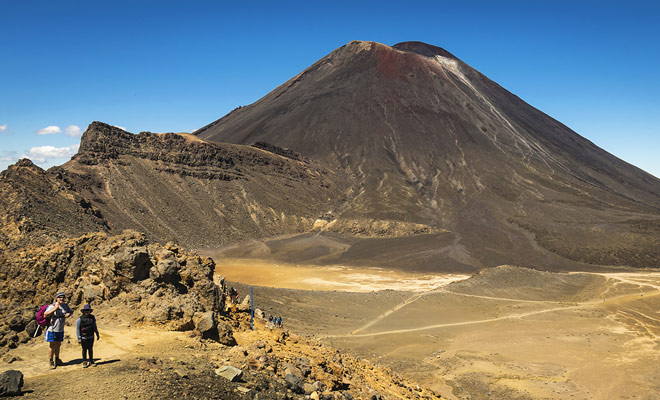
The Tongariro crossing offers breathtaking scenery!
The “Great walks” are not necessarily difficult hikes, but you must come with a camper equipment and know how to use it properly. With an average of 50 km to travel over several days, you will have to camp under the stars on authorized camp grounds ($3 to $15 per night) or spend your nights in huts to be reserved imperatively several months to the advance.
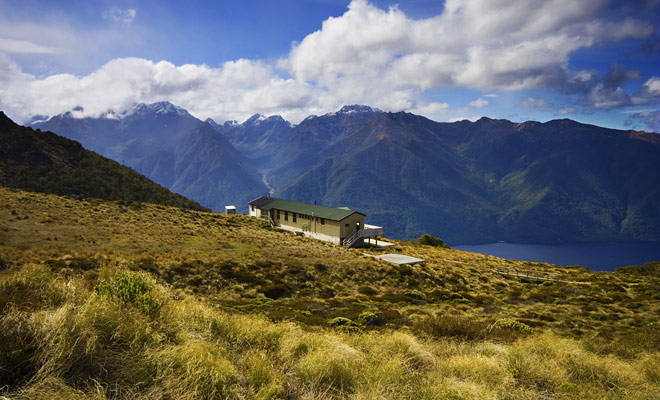
The huts allow you to rest and spend the night.
Access to national parks is free in New Zealand, but huts are subject to a fee. You will pay approximately $10 to $40 per night and per participant, with a reduced number of passes available during the high season (December to March). The quota of 90 hikers per day (notably at the Milford Track) is your worst enemy, especially as wild camping (outside the authorized areas) is prohibited by the Department of Conservation (DOC).
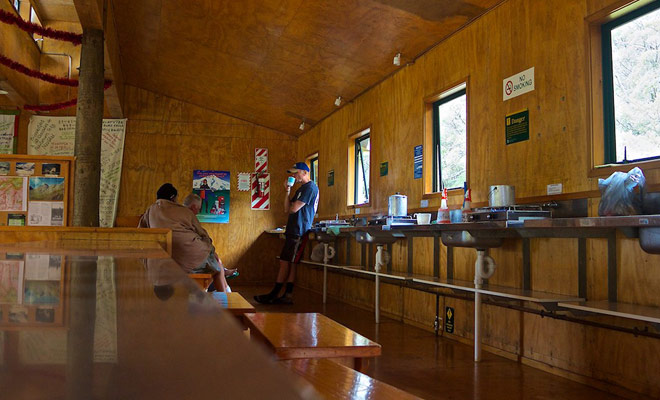
The huts are arranged to accommodate the hikers.
The classic hut equipment is quite spartan, but the common hot-water supply allows a brief toilet and you can cook on gas stoves. Mattresses are not particularly comfortable, but a full day's walk usually makes it possible to find sleep in a few minutes.

Do not leave your belongings in evidence in the car.
Warning! Few hikes form a loop and the points of departure and arrival can be distant of several tens of kilometers.
It is possible to book shuttles at the information centers (iSite) but the service is often suspended during the low season.
If you park your vehicles in the nature, do not leave anything visible inside, even if theft is rare in New Zealand, it remains possible.
Some companies carry your luggage from one shelter to another, leaving you free to hike without carrying a heavy backpack.
To help you plan your trip, I have prepared a presentation of each New Zealand's Great Walk:
| HIKE | LOCATION | DISTANCE | DURATION |
|---|---|---|---|
| Lake Waikaremoana | North Island | 46 km | 3 to 4 days |
| Tongariro Alpine Crossing | North Island | 19.6 km | 1 day |
| Whanganui Journey (by kayak) | North Island | 145 km | 5 days |
| Abel Tasman Coast Track | South Island | 54 km | 3 to 5 days |
| Heaphy Track | South Island | 78 km | 4 to 6 days |
| Kepler Track | South Island | 60 km | 3 to 4 days |
| Milford Track | South Island | 54 km | 4 to 5 days |
| Routeburn Track | South Island | 32 km | 2 to 4 days |
| Rakiura Track | Stewart Island | 32 km | 3 days |
Lake Waikaremoana - North Island
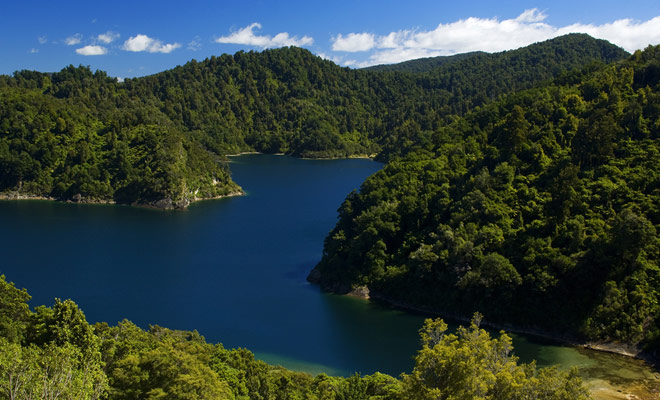
The Lake Waikaremoana trek.
The trail that runs alongside Waikaremoana Lake (the “rippling sea” in Maori) alternates beaches and podocarp forests in Te Urewera National Park on the North Island. The most beautiful panorama is “only” 9 km from the start of the hike: Panekire Bluffs offers a breathtaking open view. Good news for beginners: the presence of water taxis makes it possible to split its course without being forced to camp there by night.
Tongariro Alpine Crossing - North Island
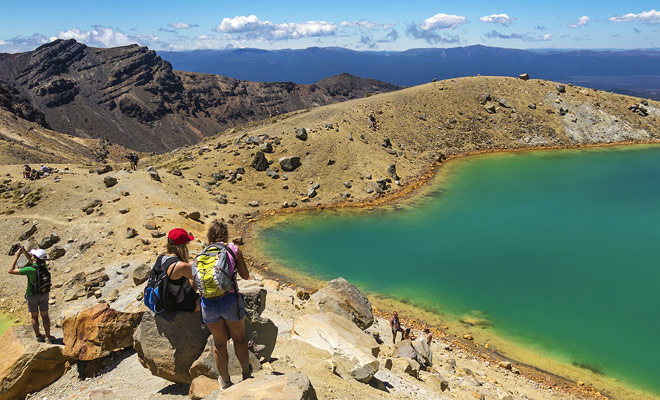
The turquoise lakes of the Tongariro Alpine Crossing.
The world-famous volcanic landscapes of the Tongariro Alpine Crossing and its turquoise lakes are part of the UNESCO World Heritage Sites. Nearby, the Ngaurohe Volcano (still active) represents the Mountain of Destiny in The Lord of the Rings. The hike takes place over a whole day and is the subject of an extensive guide on Kiwipal.
Whanganui Journey - North Island
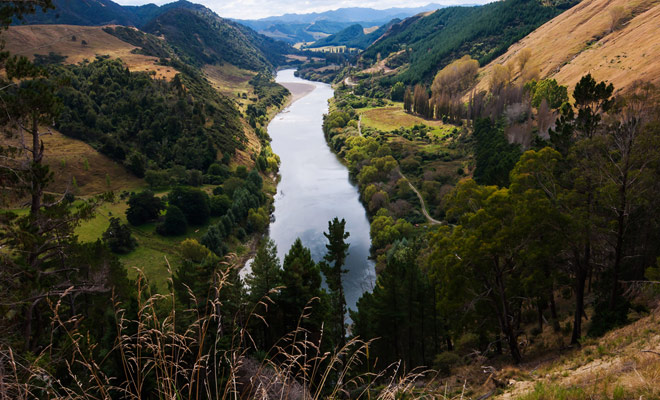
Follow the Whanganui River by kayak.
Most of the hike takes place on the Whanganui River (North Island) where you'll navigate on a kayak or canoe. The river which winds between hills and cliffs gives the impression of relive some scenes of The Lord of the Rings. A journey to be made in the presence of a guide to discover Maori culture.
Abel Tasman Coast Track - South Island

Abel Tasman Park is a paradise for kayaking and hiking.
New Zealand's most famous national park is also the sunniest in the country. The track that runs along the coast allows you to reach beaches of fine orange sand where you can bathe in turquoise water. Water Taxi facilitate the organization of hiking and allow to alternate with kayaking excursions to observe sea lions.
Heaphy Track - South Island
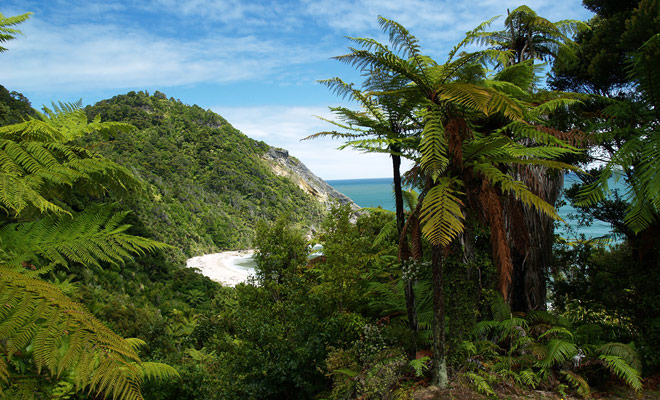
Kahurangi National Park where palm trees grow.
The highlight of South Island's Kahurangi National Park is its wide variety of landscapes. The itinerary alternates forest passages, spectacular mountain trails, rivers and waterfalls to end on a deserted beach lined with Nikau palm trees.
Kepler Track - South Island
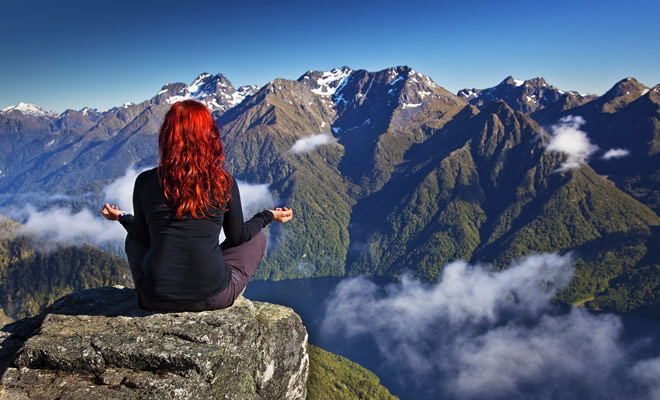
The Kepler Track is the gateway to the Fiordland.
The Kepler Track of the South Island is a recent semi-alpine hike (1988) originally created exclusively for hikers.
The forest trail, along the shores of lakes Te Anau and Manapouri, leads to Mount Luxmore at an altitude of 1400 m and then forms a loop with the starting point.
The large plains of tussock in English swept by the wind extend as far as the eye can see and the panoramas on the lakes are truly exceptional.
Milford Track - South Island
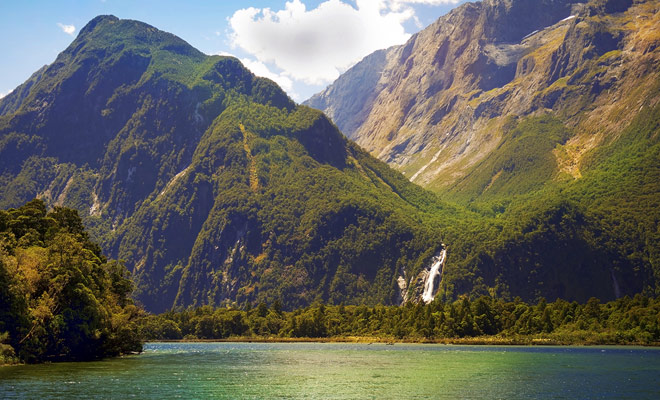
The Milford Track is probably the most beautiful hike in the world.
The Milford Track is considered to be the best trek in the world for more than a century. The trail crosses the impenetrable Fiordland's forests and crosses mountain passes up to the legendary Milford Sound (the most beautiful fjord in the country) and the Sutherland Falls (a 580-meter waterfall!).
Routeburn Track - South Island

The Routeburn Track joins the Milford Sound.
This popular hike with spectacular views is the shortest on the South Island. Its starting point in Mount Aspiring National Park is close to Queenstown, but the path to Lake Te Anau does not form a loop and it takes 4-5 hours (350 km) to get back to the starting point by car!
Rakiura Track - Stewart Island

The Rakiura hike is the third island of the country.
In reality, New Zealand does not have two islands, but three! Stewart Island is practically uninhabited and completely covered by a wild forest. The 15,000 kiwis of the Rakiura National Park come out during the day and not by night, contrary to everywhere else in the country.
Te Araroa Trail: A 3,000 Km Hike!

The 3000 km of Te Araroa crosses all of New Zealand.
The 3,000 kilometers hiking trails of the Te Araroa ("the great walk" in Maori-language) cross the two main islands of the country and allow to admire the most beautiful landscapes of New Zealand. It is one of the longest hiking trails in the world!
Te Araroa is a dream come true after years of work that have mobilized an army of thousands of volunteers. It took an infinite patience and courage to develop paths that cross wild forests, winding along the volcanoes to reach deserted beaches of fine sand.
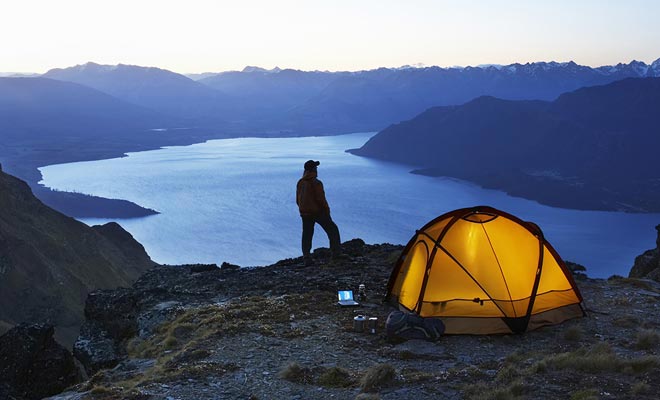
Freedom camping is allowed in specific locations.
It is, in a way, the ultimate hike, the one we keep in a corner of our mind, but which we postpone unceasingly to the next day. Only a minority of trek enthusiasts can consider doing the whole trail, but nothing prevents you from following only a small part of the Te Araroa!

It takes at least three months to complete Te Araroa.
The average speed of a walker on the North Island is about 2.3 km per hour, a figure to be revised downward on a South Island whose relief is much more marked.
Such a long trip requires considerable preparation, an excellent physical condition and a substantial budget.
The entire Te Araroa trail covers more than 3000 km on the two islands of the country!
On the map, it takes at least five hours of walking a day (about 10-15 km) to complete the path in four to six months. With a tourist visa limited to three months, you will have to settle for a single island or consider asking a Working Holiday Visa. Check the official website to find the best solution for your profile.
If you decide to embark on the adventure, contact the editorial team of Kiwipal: we will be happy to retrace your journey in an interview.
Safety Instructions for Hikers.

Despite its beauty, nature remains wild and is not without danger.
Observing Bear Grylls a former British commando and star of the TV show “Man versus Wild” sharing his survival techniques in New Zealand's Fiordland is kind of an electroshock. Some areas of the country are particularly wild and weather conditions can surprise inexperienced hikers.
The more spectacular and beautiful a landscape is, the more likely travelers will tend to neglect safety instructions. It is a phenomenon well known to professional guides: beauty seems to be in contradiction with the very notion danger and it pushes the travelers to adopt behaviors at risk.
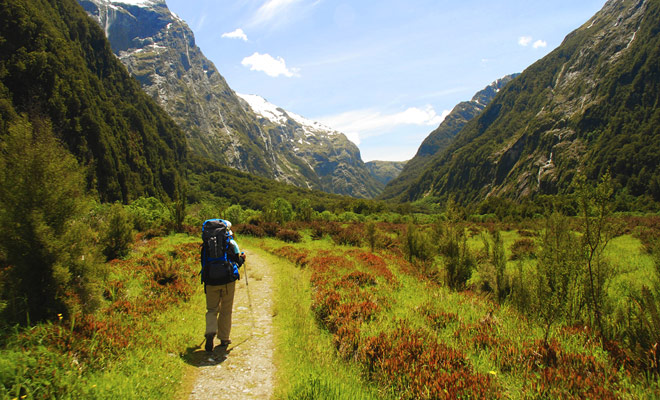
Hiking is not dangerous if you stay focus.
In 2014, two Frenchmen who were kayaking on Lake Wakatipu drowned in spite of repeated warnings by locals about the changing weather.
I could multiply stories of tragedies, but I think the message is clear: do not listen to the idiotic advice that can be read in forums or on Facebook. To be safe requires knowledge and not just prudence.
The advice of the first comer is often limited to the stupid “if I did then you can do it” which is responsible for so many accidents.
Very often these are simple boastings which do not engage their authors, but can be very dangerous for those who take them literally.

Weather conditions are the risk factor to be monitored.
Trust the qualified iSite staff to inform you about weather and hiking conditions. Did you know, for example, that you should never camp in the bed of a dry river? Do you know how to cross a river in case of emergency? All these techniques cannot be improvised, and the presence of a professional guide during a hike of several days is essential if you are a beginner.
Here is the Hiking code that I encourage you to reread:
| BASIC RULE | PRACTICAL APPLICATION |
|---|---|
| Plan your itinerary | Find the nearest iSite and question the staff about difficulty and duration of the trek. |
| Signal your intention | Do not go hiking without signaling your intentions (use the Outdoor Intention website for example) and keep a phone on you with emergency numbers. |
| Watch the weather | Weather in New Zealand can change abruptly, and you must be equipped to face rain at any time. |
| Know Your Limits | Choose a suitable hike and do not overestimate your physical abilities. |
| Carry Food and Water | Always plan more supplies than necessary. |
Watch out for Sunburn!
The advice may seem obvious, but beware of sunburn. The ozone layer is thinner than in Europe and the sunscreen will be your best friend even if the sky is covered. Do not neglect the repellent against the sandflies that live in the Fiordland (I have already warned you about these tiny flying demons in my guides about Milford Sound and Doubtful Sound.
Practical Advice for Beginners (Without Jargon)
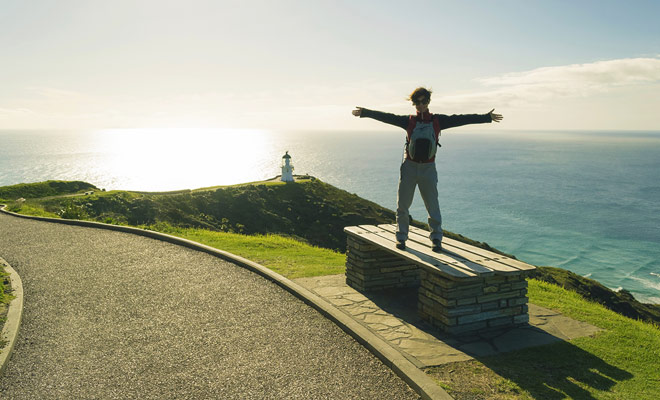
To enjoy it you have to arrive fit in New Zealand.
There are no words to describe the beauty of the landscapes of New Zealand. A few strolls are enough to get satisfaction, but if your physical condition allows, I recommend you to experience a full-day hike!
Do not impose yourself a great walk if it is not in your habits to face such challenge.
Some people told me they felt obliged to go on a hike just because they were in New Zealand...
Others fear the judgment of their friends if they return from a country famous for its outdoor activities without having done any real hike.
Do not impose yourself an excessive rhythm, and take a minute to consider if you are in a competition or on vacation?
Any aborted hike leaves regrets and undermines morale for the rest of the trip. Of the 80,000 travelers who try to accomplish the Tongariro Crossing each year, how many are exhausted at the arrival?

The hike leaves memories imperishable.
Try to practice sports before departure! If you take a few days to recover, remember it will be the same in New Zealand (even if the excitement of the journey is a great motivation to go on). Dragging nasty muscular aches is not the best way to enjoy a stay.
Needless to break records to have a pleasant stay in the Kiwis land!
Because the exhausted walker succumbs more easily to the sirens of junk-food, he creates a vicious circle that installs fatigue, prolonged by the hours of driving. It is common to feel exhausted at the two thirds of the stay if one pulls too much on the string (disputes between travelers are more frequent in such condition).
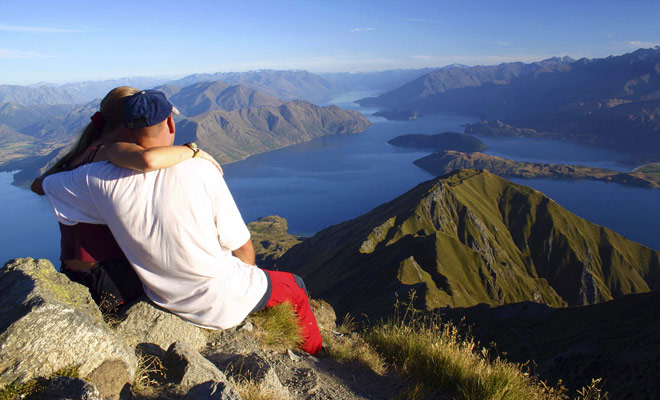
Take time to enjoy the scenery quietly.
Obviously, I do not want to discourage you, but to help you assess your real fitness level.
A properly prepared hike does not present any particular risks and leaves great memories.
Our friend Ben is an adventurous kiwi who is always happy to go hiking.
He is an expert of most great walks, and you can ask him any questions about New Zealand!


Questions & Answers.

What can I do for you? I'm an expert of New Zealand's treks and I will be happy to help you prepare your walks in National Parks!
- All topics ... 21 answers in total
- Safety Instructions 5 answers
- Choose Your Hike 4 answers
- Great Walk 4 answers
- The Hiking Gear 4 answers
- National Parks 2 answers
- Weather Forecast and Hiking Season 2 answers
Safety Instructions
- To whom can I report my hiking route?
There is a dedicated internet service that allows you to indicate your itinerary and the expected arrival time. Relief will be dispatched if you do not give a sign of life at the appointed time.Outdoor Intention
- Do you need to a doctor’s advice before a great walk?
Any sporting activity should be monitored by a doctor, especially if you are a beginner hiker.
- Are there any dangerous animal species in NZ?
There is a very rare spider whose bite can be fatal, but the last death reported going back more than a century and a vaccine exists in pharmacies. New Zealand can be considered a country devoid of dangerous animal species.
- Why should we never camp in the bed of a river?
Because a heavy rainfall distant of several tens of kilometers, or the sudden advance of a glacier can cause a sudden rise of waters. Such incidents were avoided during the filming of Peter Jackson's films.
- Can we cross rivers?
It is not advisable to cross a river unless this is absolutely necessary. The water that comes from the glaciers is so cold it can paralyze you and the current take you away in an instant. To cross in an emergency situation, it is better to do it with several people by holding each other to form a compact block that will better resist the current.
Choose Your Hike
- What is the best hike in New Zealand?
A very subjective question! According to most travel guide, it is the Milford Track on the South Island. I share this point of view when it comes to hikes over several days, otherwise I would recommend the Tongariro Alpine Crossing instead.
- What is the best area of the country for hiking?
For my part, I prefer the Central Otago region. That being said, every traveler has his / her own preferences and the answer to this question can only be subjective.
- What is the best island in the country for hiking?
You will read everywhere that the South Island offers the most spectacular scenery. In reality, the two islands are very different and the enthusiasts of the country know that it is impossible to choose between the two islands.
- Does New Zealand really look like Middle Earth?
Many landscapes that appear in the films are not even reworked during post production. Tolkien was thinking mainly of Switzerland when he wrote his works, but since he never had the opportunity to visit New Zealand, we will never know his point of view on the matter.
Great Walk
- Should we book the great walks?
Yes, because you will not have a chance to find a place at the last minute. Two months before departure it will often be too late.
- Are the refuges paying?
Yes, and the limited number of places also requires reserving several months in advance.
- How to get more information about Te Araroa?
I invite you to consult the official website of this great march that crosses the whole country from North to South.Te Araroa
- Can children make the Tongariro Alpine Crossing?
I consider that the Tongariro is a suitable hike from 15 years. It is possible to follow the track by being younger, but at the risk of being exhausted and especially of being bored.
The Hiking Gear
- Can we hike with simple jeans?
If the weather is fine, I suggest short walks. The wearing of jeans is not advisable in the mountains or if it rains, because the fabric takes too much time to dry.
- Can we just wear sneakers?
For easy hikes, it is quite possible, but nonetheless deprecated over long distances.
- Why do you have to clean your shoes before you go to New Zealand?
The airport's biosecurity services check whether the shoes are clean to avoid importing diseases into New Zealand territory. If your shoes are dirty, they will go through a decontamination service and you will waste precious time.
- Which sports shop do you recommend?
In Europe, there are many choices among the big brands, but the wise advice is rather to be sought from the side of specialized hiking shops.Au vieux campeur
National Parks
- Are national parks paying?
The fourteen national parks of New Zealand are free, but nights spent in shelters or campsites are generally to be paid.
- Can we camp in national parks?
The campsite is authorized in certain areas specifically defined by the Department of Conservation (DOC). Outside these areas, campers are subject to fines.
Weather Forecast and Hiking Season
- Is it really cold in the mountains?
The temperatures are naturally cooler in altitude, even in summer. If the wind rises and the rain begins to fall, a sudden drop in temperature is to be expected.
- What is the best season for hiking?
Late summer and early autumn (February to March) to enjoy a more favorable weather. But there are many advantages to visiting the country the rest of the year, if only to benefit from discounted rates.


